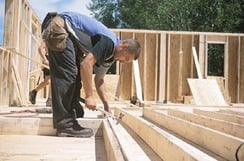The Difference the Right Employees Can Make For Your Construction Business
 Having the right employees at your business can make a huge difference to your business in so many ways.
Having the right employees at your business can make a huge difference to your business in so many ways. Over the holidays this Christmas season I went on an annual goose hunting trip in Illinois with some contractor buddies. My first return flight was delayed and I was at risk of making my connection to get back home. I was obviously bummed out. But, thanks to just one exceptional airline employee, I made the connection and got back in time to celebrate the New Year with my family. Here's what that employee did and why you should seek, choose and train your employees to be just like her.
First off she had a great attitude and presented herself well
The woman who checked me in was well dressed and well groomed. Sure she had to wear a uniform (and so should your employees), but in addition to wearing professional attire she obviously also had a lot of self-respect and presented herself well. Unlike others I observed working around her she was professionally groomed, interacted with a genuine smile and spoke with a professional vernacular. I suspect someone raised her to be that way and I could tell it was natural for her, not an act. In my opinion hiring her was a great investment.
Next, she managed my expectations and offered proactive assistance
 As she checked me in she made me aware that my flight was likely to be delayed and therefore making my tight connecting flight might be at risk. I had never had anyone else at any airline do this at check in. She also told me why it might be late before I had chance to ask her why. By doing so my attitude about my situation was already less stressful. She then helped me make a "Plan B" in case I missed that flight. By doing so I went to the gate in a much better frame of mind than the frame of mind I would have been in if I discovered my possible dilemma at the gate.
As she checked me in she made me aware that my flight was likely to be delayed and therefore making my tight connecting flight might be at risk. I had never had anyone else at any airline do this at check in. She also told me why it might be late before I had chance to ask her why. By doing so my attitude about my situation was already less stressful. She then helped me make a "Plan B" in case I missed that flight. By doing so I went to the gate in a much better frame of mind than the frame of mind I would have been in if I discovered my possible dilemma at the gate. Then she was at the gate and was working hard to mitigate potential challenges
Yes, the same woman who checked me in soon came to work the gate, and was all by herself. I suggest, like a small business, the gate at that small airport could not support additional overhead. She was obviously cross trained by her employer to perform a wide variety of tasks and to do so very efficiently. For that I not only credit her employer for properly training her, but for also hiring an employee with the right cognitive abilities and a desire to learn. For that I can probably also credit her as well as whoever raised her and or mentored her in her formative years. With her actions, knowledge and a professional demeanor she got the incoming passengers squared away, prepped things for my outbound flight, and very efficiently got us all boarded faster that I have ever experienced before. And I travel a lot! She minimized the potential delay big time like it was second nature.
The good news was that I made my connection to get home.
 The better news, for me and her employer, is that she restored my faith in her company as a preferred option. The next time I have a choice when deciding between available airline options to serve my traveling needs my experience that day with her will definitely become part of my buying decision.
The better news, for me and her employer, is that she restored my faith in her company as a preferred option. The next time I have a choice when deciding between available airline options to serve my traveling needs my experience that day with her will definitely become part of my buying decision.I hope sharing my experience that day will help you make better hiring plans and decisions. For additional help and insight check out his article titled "One Simple but Powerful Tip for Hiring the Right Employees”


 As I pointed out in
As I pointed out in 
 Personal qualities needed to be a Lead Carpenter
Personal qualities needed to be a Lead Carpenter
 Skilled Carpenters are assumed to have the trade skills needed to do the work at hand and to understand construction. But just because a carpenter has these skills doesn’t necessarily also mean he or she has the rest of what it takes to be a successful Lead Carpenter. Below is the first half of a list of key skills a carpenter should have or will need to acquire to become a great Lead Carpenter. I created this list to help carpenters and construction business owners improve their chances of success developing Lead Carpenters and a true Lead Carpenter System.
Skilled Carpenters are assumed to have the trade skills needed to do the work at hand and to understand construction. But just because a carpenter has these skills doesn’t necessarily also mean he or she has the rest of what it takes to be a successful Lead Carpenter. Below is the first half of a list of key skills a carpenter should have or will need to acquire to become a great Lead Carpenter. I created this list to help carpenters and construction business owners improve their chances of success developing Lead Carpenters and a true Lead Carpenter System. 
 Speaking: Ability to speak clearly including selecting language, tone of voice, and gestures appropriate to a specific audience.
Speaking: Ability to speak clearly including selecting language, tone of voice, and gestures appropriate to a specific audience. Creative Thinking: Has the ability and is not afraid to use imagination freely to combine ideas or information in new ways. Can easily make connections between ideas that seem unrelated to others.
Creative Thinking: Has the ability and is not afraid to use imagination freely to combine ideas or information in new ways. Can easily make connections between ideas that seem unrelated to others. Choosing your MA CSL renewal class simply by price or location may not be a good investment for some MA CSL license holders. Sure, you may get the credits you need, but why not also seek to increase the return on investment of your hard earned money!
Choosing your MA CSL renewal class simply by price or location may not be a good investment for some MA CSL license holders. Sure, you may get the credits you need, but why not also seek to increase the return on investment of your hard earned money!
 The first is whether the class instructor is experienced as a teacher and can effectively help you and or your employees learn the topic at hand. Some trainers have degrees in education and lots of previous experience actually teaching. Other trainers lack the skills and or experience needed to help you actually understand and then apply what you learn in class in the real world. I suggest you choose a trainer with a proven educational background. If you don’t already have past experience with the trainer and his/her abilities, referrals and or testimonials from past attendees can be a big help when making your selection.
The first is whether the class instructor is experienced as a teacher and can effectively help you and or your employees learn the topic at hand. Some trainers have degrees in education and lots of previous experience actually teaching. Other trainers lack the skills and or experience needed to help you actually understand and then apply what you learn in class in the real world. I suggest you choose a trainer with a proven educational background. If you don’t already have past experience with the trainer and his/her abilities, referrals and or testimonials from past attendees can be a big help when making your selection. There are many remodeling business myths that seem to have become truths for way too many remodelers. That’s too bad. Believing those myths may be holding them back from being able to grow their businesses. Allowing these myths to remain in place will definitely prevent remodelers from successfully growing their businesses past the $1 Million installed sales threshold.
There are many remodeling business myths that seem to have become truths for way too many remodelers. That’s too bad. Believing those myths may be holding them back from being able to grow their businesses. Allowing these myths to remain in place will definitely prevent remodelers from successfully growing their businesses past the $1 Million installed sales threshold. Again, will you jump off the bridge, too? Will Delta Airlines let you pay after you land? Completing remodeling services without being paid for them before you do them is in my opinion foolish, and a huge risk for most remodelers. It instantly creates cash flow challenges in a business where cash is king. Breaking $1M without good cash flow might be the death of your business. Here is how you can create payment schedules that keep you ahead of your customer:
Again, will you jump off the bridge, too? Will Delta Airlines let you pay after you land? Completing remodeling services without being paid for them before you do them is in my opinion foolish, and a huge risk for most remodelers. It instantly creates cash flow challenges in a business where cash is king. Breaking $1M without good cash flow might be the death of your business. Here is how you can create payment schedules that keep you ahead of your customer: 
 You can invest now to train managers or employees and to rework structural shortcomings within your business. Or you can pay forever by running a shoddy show that won't give you the financial returns that it takes to stay in business and retire before your body eventually gives out.
You can invest now to train managers or employees and to rework structural shortcomings within your business. Or you can pay forever by running a shoddy show that won't give you the financial returns that it takes to stay in business and retire before your body eventually gives out. 
 If you have lost focus or lack the discipline to put business systems in place and stick to them it’s time to commit to and practice new attitudes and behaviors. Before you grow your business consider the adequacy of your financial system to predict and measure results. Do you have a formal marketing plan to guide you or are you winging your marketing? Do you have well thought out job descriptions you can use to recruit, qualify and hold new hires accountable to? Have you established benchmarks for the performance of your business systems? If you don’t have or do these things what example are you setting and what type of employees will join and or stay with your business?
If you have lost focus or lack the discipline to put business systems in place and stick to them it’s time to commit to and practice new attitudes and behaviors. Before you grow your business consider the adequacy of your financial system to predict and measure results. Do you have a formal marketing plan to guide you or are you winging your marketing? Do you have well thought out job descriptions you can use to recruit, qualify and hold new hires accountable to? Have you established benchmarks for the performance of your business systems? If you don’t have or do these things what example are you setting and what type of employees will join and or stay with your business? A growing business that wants to attract and keep good employees needs to act professional. This means having a proactive and strategic marketing plan in writing. It means preparing a financial operating budget and staying within it. It means investing in training and mentoring your employees to be the future leaders your business will need. It means creating a profit sharing strategy and or compensation strategies based on performance. It also means operating legally and safely.
A growing business that wants to attract and keep good employees needs to act professional. This means having a proactive and strategic marketing plan in writing. It means preparing a financial operating budget and staying within it. It means investing in training and mentoring your employees to be the future leaders your business will need. It means creating a profit sharing strategy and or compensation strategies based on performance. It also means operating legally and safely. Before you as the leader can step away from your business the business needs to have a new leader already in place. Many business owners are forced back into leading and managing their businesses because the person they hired to do so did not have adequate leadership skills and or wasn’t yet seen as the leader by the other employees. Don’t make this mistake at your business. Before you step away make sure there is a successful transition of leadership from you to the new leader; in the eyes of the employees as well as your customers. Also, make sure you have a way to measure the performance of the business and the leader before you pull away. Again I suggest you have this in place and confirm it is working before you transition out of your office and your roles at the business.
Before you as the leader can step away from your business the business needs to have a new leader already in place. Many business owners are forced back into leading and managing their businesses because the person they hired to do so did not have adequate leadership skills and or wasn’t yet seen as the leader by the other employees. Don’t make this mistake at your business. Before you step away make sure there is a successful transition of leadership from you to the new leader; in the eyes of the employees as well as your customers. Also, make sure you have a way to measure the performance of the business and the leader before you pull away. Again I suggest you have this in place and confirm it is working before you transition out of your office and your roles at the business.
 My Great Uncle's brother was a custom wood worker and built everything from tiny jewelry and cigarette boxes with minute inlay and detail, to a full spectrum of furniture and woodworking. He built his shop in the cavernous basement of an ancient brownstone five blocks from the harbor in Philadelphia. In this shop he had every true carpenter's tool of the day including an entirely leather belt driven coping lathe that he built himself. Every tool had a place and there was a place for every tool, all sharp, oiled and at the ready. From my uncle I learned the necessary task of stone sharpening; honing the edges of every tool, from chisels and planes. I also learned how to sharpen each tooth of a circular blade and the art of "setting" the teeth of each handsaw in the shop, positioned teeth down and stacked front to back in the handmade wooden tool boxes that cuddled every tool.
My Great Uncle's brother was a custom wood worker and built everything from tiny jewelry and cigarette boxes with minute inlay and detail, to a full spectrum of furniture and woodworking. He built his shop in the cavernous basement of an ancient brownstone five blocks from the harbor in Philadelphia. In this shop he had every true carpenter's tool of the day including an entirely leather belt driven coping lathe that he built himself. Every tool had a place and there was a place for every tool, all sharp, oiled and at the ready. From my uncle I learned the necessary task of stone sharpening; honing the edges of every tool, from chisels and planes. I also learned how to sharpen each tooth of a circular blade and the art of "setting" the teeth of each handsaw in the shop, positioned teeth down and stacked front to back in the handmade wooden tool boxes that cuddled every tool. Eventually the first miter boxes, buck saws and smaller radial arm saws arrived and we started to move away from the hand tools like the Yankee screw driver, the brace and bit and the miter knife. We started to use nail guns, carbide blades and a plethora of modernized tools to save time and money; not knowing that we would forever kill the "Traditional Carpenter". I witnessed men become unwilling to use a hand tool. They were unwilling to know, understand or simply feel the joy of building something you hoped would be there forever, built with your own two hands. Those days are gone.
Eventually the first miter boxes, buck saws and smaller radial arm saws arrived and we started to move away from the hand tools like the Yankee screw driver, the brace and bit and the miter knife. We started to use nail guns, carbide blades and a plethora of modernized tools to save time and money; not knowing that we would forever kill the "Traditional Carpenter". I witnessed men become unwilling to use a hand tool. They were unwilling to know, understand or simply feel the joy of building something you hoped would be there forever, built with your own two hands. Those days are gone.

 One employee was found using a table saw without using safety glasses. This offense came with a $1200 fine. The inspector noted the violation was corrected during inspection.
One employee was found using a table saw without using safety glasses. This offense came with a $1200 fine. The inspector noted the violation was corrected during inspection. Mark shared that his first experience with OSHA was back in 1979 when working as a project supervisor. An OSHA inspector showed up at the job site with three books under his arm. Mark said the inspector greeted him with; “You’re going to get a fine today. I’ve got three books here and I’m sure I can find something in one of them”.
Mark shared that his first experience with OSHA was back in 1979 when working as a project supervisor. An OSHA inspector showed up at the job site with three books under his arm. Mark said the inspector greeted him with; “You’re going to get a fine today. I’ve got three books here and I’m sure I can find something in one of them”. 
 The great recession changed this scenario somewhat due to layoffs and downsizing. The surplus of unemployed field workers got as high as 27% for the construction industry during the recession. Unfortunately many skilled workers left the industry for other jobs, less physical jobs and or better job security. This has set up what is expected to be a major labor shortage problem for our industry as the economy and construction pick up again. Many contractors around the country are already reporting challenges finding skilled carpenters to keep up with construction demand. As the demand goes up, so will the wages that carpenters can demand to either stay at their current jobs or that other contractors will use to lure workers away to work for them.
The great recession changed this scenario somewhat due to layoffs and downsizing. The surplus of unemployed field workers got as high as 27% for the construction industry during the recession. Unfortunately many skilled workers left the industry for other jobs, less physical jobs and or better job security. This has set up what is expected to be a major labor shortage problem for our industry as the economy and construction pick up again. Many contractors around the country are already reporting challenges finding skilled carpenters to keep up with construction demand. As the demand goes up, so will the wages that carpenters can demand to either stay at their current jobs or that other contractors will use to lure workers away to work for them. If you plan to hire additional carpenters as your business volume picks up now is the time to put a plan together for not only finding, but also attracting good carpenters to work for your business and then to get them to stay with your business. The compensation package you put together should not only capture their interest, but also help them see opportunities for future growth and increased compensation if they are loyal and motivated.
If you plan to hire additional carpenters as your business volume picks up now is the time to put a plan together for not only finding, but also attracting good carpenters to work for your business and then to get them to stay with your business. The compensation package you put together should not only capture their interest, but also help them see opportunities for future growth and increased compensation if they are loyal and motivated. The automobile industry uses a flat rate manual to determine the labor costs for auto repair services. The strategy they use is not to estimate the number of hours to do a certain task, but rather the typical actual cost of the labor to perform the task. A repair shop that uses flat rates pays their employees for what they accomplish, not how long it took them to do it. A construction or remodeling business could do something similar. Such a strategy could also help the business and the employees learn where to invest training to improve performance and stimulate wage increases for those who buy into performance based opportunities.
The automobile industry uses a flat rate manual to determine the labor costs for auto repair services. The strategy they use is not to estimate the number of hours to do a certain task, but rather the typical actual cost of the labor to perform the task. A repair shop that uses flat rates pays their employees for what they accomplish, not how long it took them to do it. A construction or remodeling business could do something similar. Such a strategy could also help the business and the employees learn where to invest training to improve performance and stimulate wage increases for those who buy into performance based opportunities.






